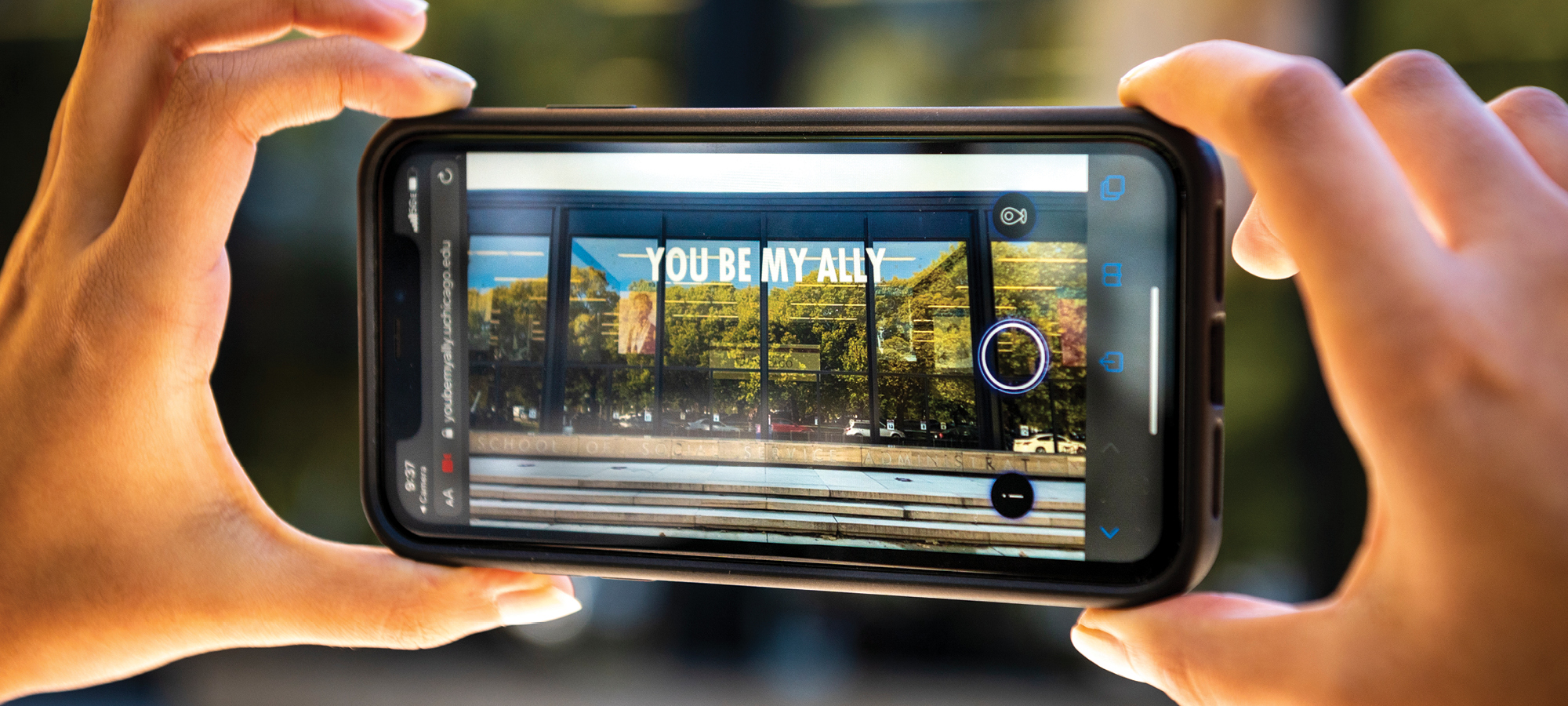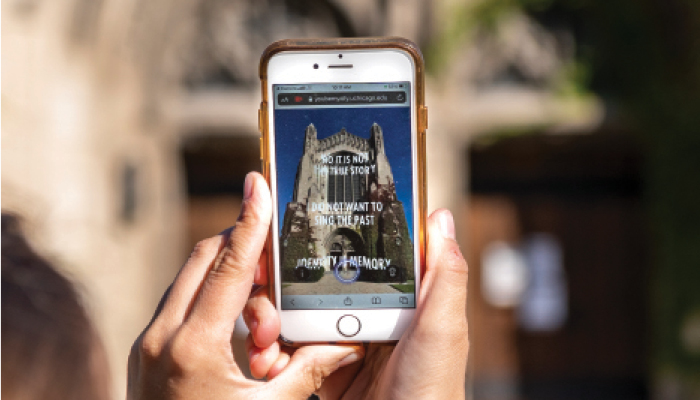
Jenny Holzer’s (EX’74) project takes its title, YOU BE MY ALLY (projected here on the facade of the School of Social Service Administration building), from a Sappho poem. (YOU BE MY ALLY, 2020 / Augmented reality app / Text: Sappho, fragment 1 from If Not, Winter: Fragments of Sappho by Anne Carson, first published by Alfred A. Knopf, © 2002 by the author. Reprinted by permission of the author and Aragi Inc. All rights reserved. / Installation: University of Chicago, Illinois, USA, 2020 / © 2020 Jenny Holzer, member Artists Rights Society (ARS), NY / Photo: Christopher Dilts)
YOU BE MY ALLY features 29 excerpts from Core curriculum readings.
Jenny Holzer, EX’74, rarely gives lectures. She seldom agrees to interviews. She prefers to let her artwork speak for itself.
Her work—printed on street posters, carved into marble, programmed into LED signs, or projected on buildings in giant letters—says things like:
PROTECT ME FROM WHAT I WANT
ABUSE OF POWER COMES AS NO SURPRISE
SPIT ALL OVER SOMEONE WITH A MOUTHFUL OF MILK IF YOU WANT TO FIND OUT SOMETHING ABOUT THEIR PERSONALITY FAST
“I like placing content wherever people look,” Holzer has said in one of her infrequent interviews, “and that can be at the bottom of a cup or on a shirt or hat or on the surface of a river or all over a building.”

At the University’s 2019 Convocation, Holzer was awarded the Jesse L. Rosenberger Medal for outstanding achievement in the creative and performing arts. Usually, recipients of the medal return later to give a lecture or workshop. When Holzer toured the campus with Laura Steward, curator of public art at UChicago, they hit upon the idea of a collaborative art project instead. “I still get goose bumps when I talk about this,” says Christine Mehring the Mary L. Block Professor of Art History, who was part of the group that nominated Holzer for the medal.
In October YOU BE MY ALLY premiered on campus and worldwide through a web-based augmented reality app. The title comes from If Not, Winter: Fragments of Sappho, translated by Anne Carson (Knopf, 2002). YOU BE MY ALLY is Holzer’s first augmented reality project with virtual projections in the United States. It’s also her first work created in collaboration with a university’s students and faculty.
Holzer began her career as a guerilla artist in the late 1970s, printing posters of what she called Truisms—brief, cryptic epigrams on a range of topics—and wheat-pasting them around New York City under cover of darkness. In 1990, she was chosen to represent the United States at the Venice Biennale, where she won its grand prize, the Leone d’Oro.

For the UChicago project, after considering other themes—free speech, gun violence—Holzer chose to focus on the readings in the Core curriculum. YOU BE MY ALLY features 29 excerpts from Core readings, culled from more than 100 pages of suggestions from UChicago students and faculty. “There were a lot—a ton,” says research assistant Emeline Boehringer, Class of 2021, who worked with professors in the Core to compile the excerpts.
Among the final selections were quotations from Plato, Friedrich Nietzsche, W. E. B. Du Bois, Virginia Woolf, and Toni Morrison, as well as Lauren Berlant, the George M. Pullman Distinguished Service Professor in English (from an article cowritten by Michael Warner of Yale): “COHERENCE IS ALWAYS PROVISIONAL.” Holzer appeared particularly interested in “what marginal voices wind up being included in the canon,” Boehringer says. When COVID-19 emerged after the project was well underway, “that definitely shaped the quotes we chose.”
On campus, viewers are able to virtually project and animate these texts on the facades of seven architecturally significant buildings: Cobb Hall (designed by the noneponymous Henry Ives Cobb), D’Angelo Law Library (Eero Saarinen), Logan Center (Tod Williams and Billie Tsien), Mansueto Library (Helmut Jahn), the School of Social Service Administration (Ludwig Mies van der Rohe), Cummings Life Science Center (I. W. Colburn), and Rockefeller Memorial Chapel (Bertram Grosvenor Goodhue). In addition, app users anywhere in the world can project the texts onto their surroundings.
In YOU BE MY ALLY, Holzer used virtual projection not as “a stand-in” for her earlier and ongoing work with real building projections, says Mehring, “but as its own medium.” Mehring points to the way the text “crawls” up the steps of SSA (her favorite) or is projected onto the Law School library’s glass facade and Rockefeller’s ivy: “None of this is technically possible for an actual projection.”
LED displays, which some critics consider Holzer’s signature medium, were also part of the project. For two days in early October, the Core curriculum texts traveled the streets of Hyde Park, other South Side neighborhoods, and the Loop in the form of LED displays on trucks.
In late October, during the run-up to Election Day, the trucks displayed messages, some written by UChicago students, encouraging viewers to vote. Among the student submissions: “YOUR BIRTHRIGHT IS MY LIFE’S DESIRE,” “YOU’RE NOT OVERREACTING,” and “APATHY IS UNACCEPTABLE.” As with all of the text in Holzer’s art—including her own writing, or those of authors taught in the Core—the messages are aggressive, public, and anonymous.
